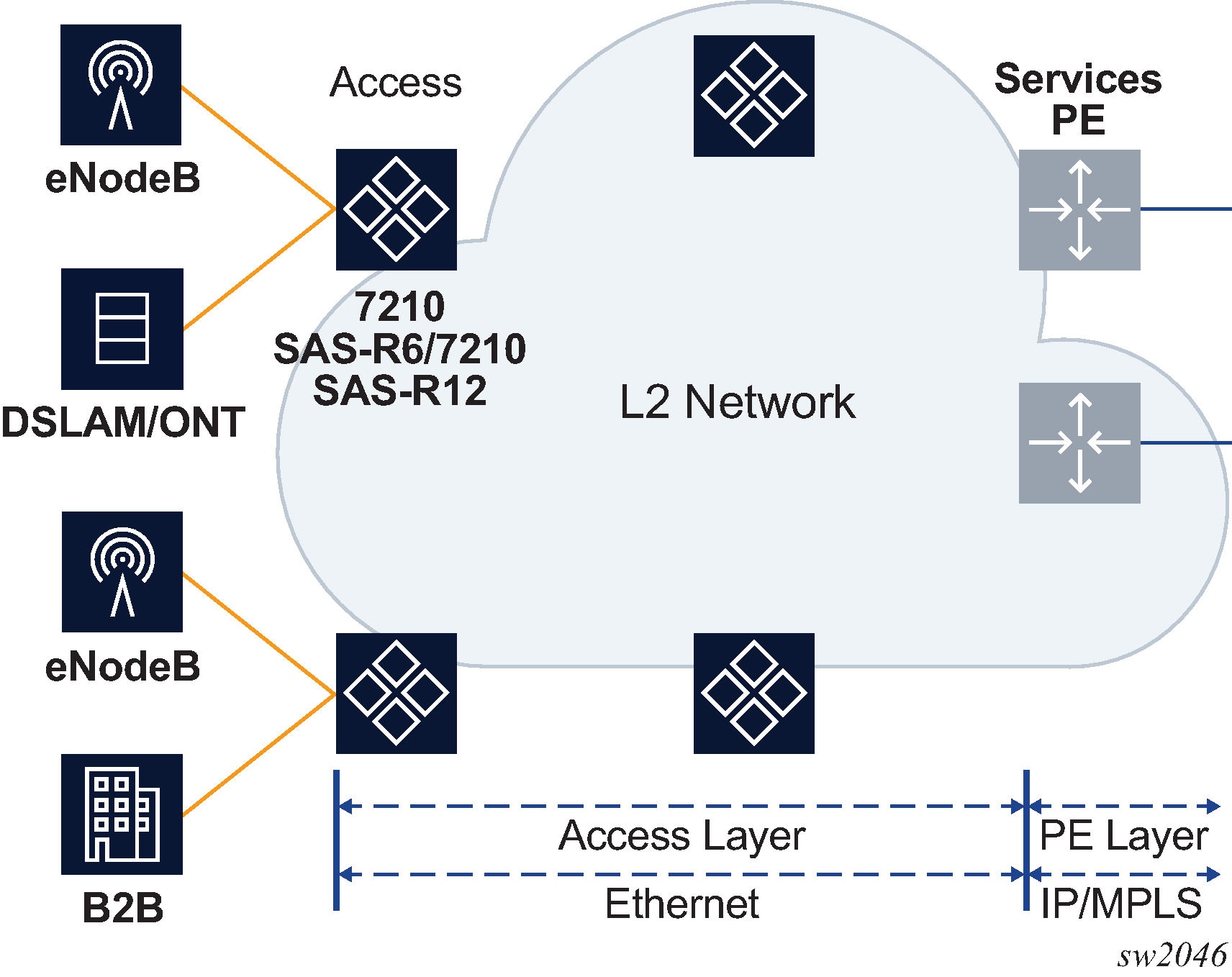In Layer 2 access networks that are used to backhaul service traffic from business services, mobile backhaul, and residential services, the 7210 SAS-R6 and 7210 SAS-R12 act as a Layer 2 carrier Ethernet switching platform with VLAN-based Layer 2 uplinks. To perform this role, the 7210 SAS-R6 and 7210 SAS-R12 must support a mode with higher SAP and service scaling. To do so, the 7210 SAS-R6 and 7210 SAS-R12 use the SAP scale mode and port-based access ingress policies.
The following figure shows the use of Layer 2 uplinks in a Layer 2 access network.

The SAP scale mode is configured using the configure>system>global-res-profile>sap-scale-mode {high | low} command. By default, the low option is configured for low SAP scale mode, which provides backward compatibility. The user can configure the high option to use high SAP scale mode, which allows the configuration of a higher number of services and SAPs. Before changing the sap-scale-mode value, the user must perform the following tasks:
Remove all service and SAP configurations.
Change the value of sap-scale-mode and enable per-port egress queuing using the configure>system>global-res-profile>qos>port-scheduler-mode command.
Reboot the node.
Reconfigure all SAPs and services as required.
In high SAP scale mode, the system supports higher SAP and service scaling for Epipe/VLL and VPLS services only. SAP and service scaling for IES, VPRN, and R-VPLS services remain unchanged.
QoS policies support port-based access ingress policies on access ports to facilitate the use of access ports as Layer 2 uplinks. With the use of ports as Layer 2 uplinks, the user can apply a single port-based access ingress policy at ingress of an access port, instead of using per-SAP ingress policies. This allows a single policy definition to be used to classify and rate-limit all traffic received over access ports used as Layer 2 uplinks (similar to a network port-based policy applied to network ports used as uplinks) instead of using per SAP ingress policies. Resources must be allocated using the configure>system>resource-profile command to use access ingress QoS policies on an access port.
In addition, only the following QoS policies can be used in the high SAP scale mode to achieve a higher scale:
access port-based egress queuing and shaping on all ports, including service delivery ports and uplinks
access port-based ingress classification and policing on uplinks
Epipe and VPLS SAPs using access port ingress QoS policies (instead of per-SAP ingress policies) on service delivery ports for higher SAP scale
IES and VPRN SAPs using table-based classification or CAM-based classification
R-VPLS SAPs using CAM-based classification and policing
The following SAP configuration restrictions apply to the high SAP scale mode; see SAPs for additional SAP configuration guidelines:
If an R-VPLS Q1.* SAP is configured, SAPs (Q1.Q2 SAP) with a matching Q1 tag cannot be configured in other VPLS, Epipe, IES, and VPRN services on the same port.
If a VPLS Q1.* SAP enabled with DHCP snooping is configured, SAPs (Q1.Q2 SAP) with a matching Q1 tag cannot be configured in other VPLS, Epipe, IES, and VPRN services on the same port. They can use other values for the Q1 tag. The reverse is also true.
The dot1p default SAP cannot be configured in R-VPLS services; it is only supported in Epipe, VPLS, IES, and VPRN services.